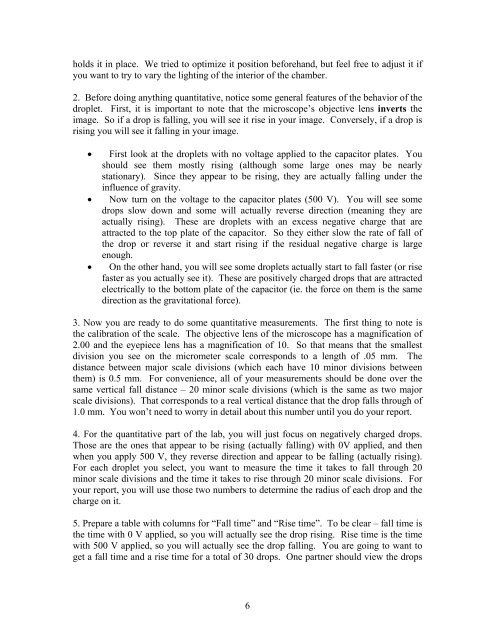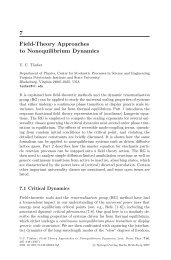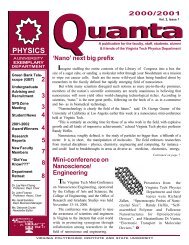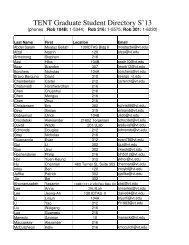Millikan writeup - Physics
Millikan writeup - Physics
Millikan writeup - Physics
Create successful ePaper yourself
Turn your PDF publications into a flip-book with our unique Google optimized e-Paper software.
holds it in place. We tried to optimize it position beforehand, but feel free to adjust it if<br />
you want to try to vary the lighting of the interior of the chamber.<br />
2. Before doing anything quantitative, notice some general features of the behavior of the<br />
droplet. First, it is important to note that the microscope’s objective lens inverts the<br />
image. So if a drop is falling, you will see it rise in your image. Conversely, if a drop is<br />
rising you will see it falling in your image.<br />
<br />
<br />
<br />
First look at the droplets with no voltage applied to the capacitor plates. You<br />
should see them mostly rising (although some large ones may be nearly<br />
stationary). Since they appear to be rising, they are actually falling under the<br />
influence of gravity.<br />
Now turn on the voltage to the capacitor plates (500 V). You will see some<br />
drops slow down and some will actually reverse direction (meaning they are<br />
actually rising). These are droplets with an excess negative charge that are<br />
attracted to the top plate of the capacitor. So they either slow the rate of fall of<br />
the drop or reverse it and start rising if the residual negative charge is large<br />
enough.<br />
On the other hand, you will see some droplets actually start to fall faster (or rise<br />
faster as you actually see it). These are positively charged drops that are attracted<br />
electrically to the bottom plate of the capacitor (ie. the force on them is the same<br />
direction as the gravitational force).<br />
3. Now you are ready to do some quantitative measurements. The first thing to note is<br />
the calibration of the scale. The objective lens of the microscope has a magnification of<br />
2.00 and the eyepiece lens has a magnification of 10. So that means that the smallest<br />
division you see on the micrometer scale corresponds to a length of .05 mm. The<br />
distance between major scale divisions (which each have 10 minor divisions between<br />
them) is 0.5 mm. For convenience, all of your measurements should be done over the<br />
same vertical fall distance – 20 minor scale divisions (which is the same as two major<br />
scale divisions). That corresponds to a real vertical distance that the drop falls through of<br />
1.0 mm. You won’t need to worry in detail about this number until you do your report.<br />
4. For the quantitative part of the lab, you will just focus on negatively charged drops.<br />
Those are the ones that appear to be rising (actually falling) with 0V applied, and then<br />
when you apply 500 V, they reverse direction and appear to be falling (actually rising).<br />
For each droplet you select, you want to measure the time it takes to fall through 20<br />
minor scale divisions and the time it takes to rise through 20 minor scale divisions. For<br />
your report, you will use those two numbers to determine the radius of each drop and the<br />
charge on it.<br />
5. Prepare a table with columns for “Fall time” and “Rise time”. To be clear – fall time is<br />
the time with 0 V applied, so you will actually see the drop rising. Rise time is the time<br />
with 500 V applied, so you will actually see the drop falling. You are going to want to<br />
get a fall time and a rise time for a total of 30 drops. One partner should view the drops<br />
6

















